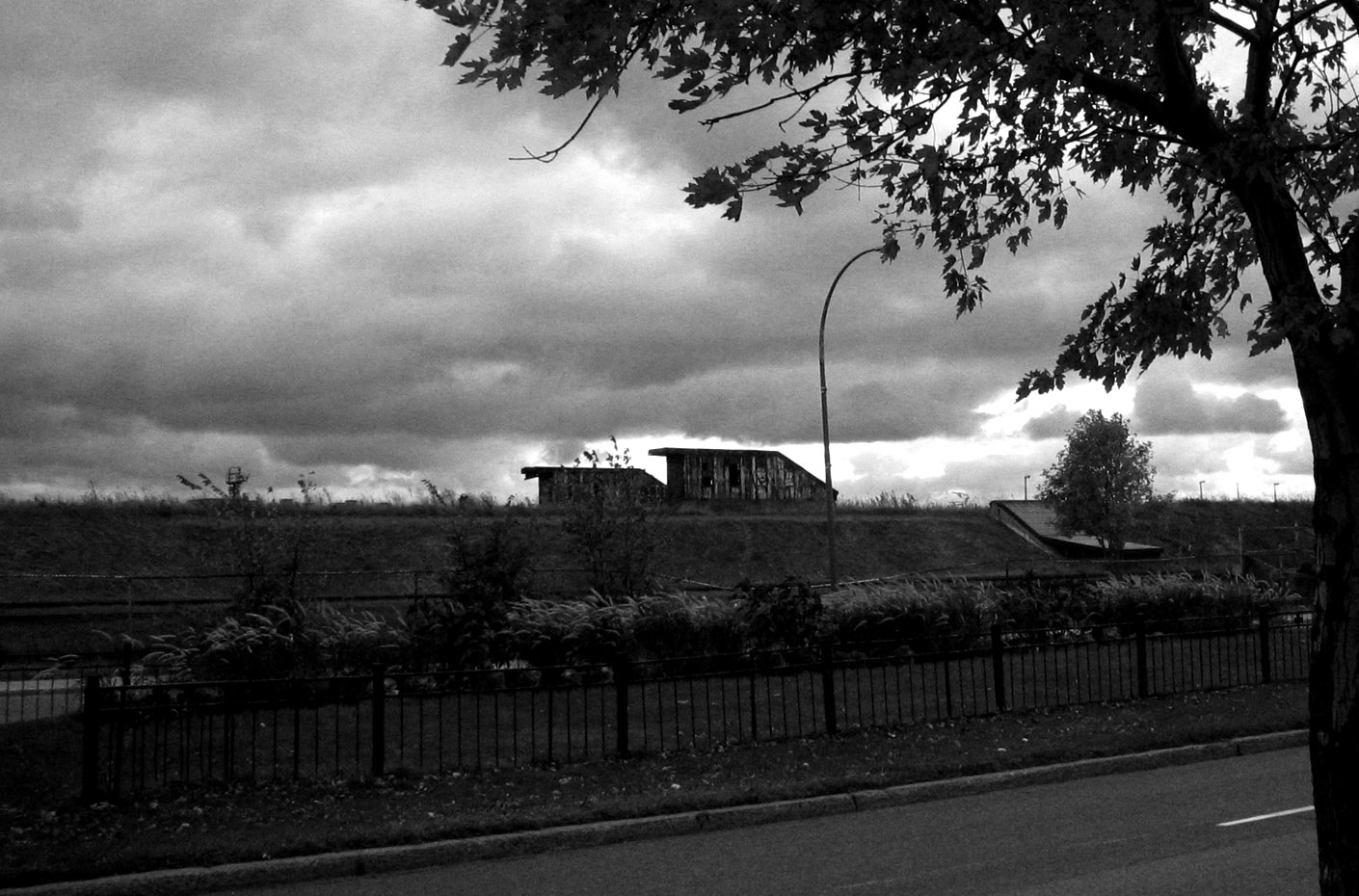- Goose Village, Montreal
Infobox Settlement
name = Goose Village
official_name = Victoriatown
settlement_type =Abandoned town
motto =
imagesize = 238x157px
image_caption = Old Victoriatown train station, today.
image_
mapsize =
map_caption =
mapsize1 =
map_caption1 =
pushpin_
pushpin_label_position = bottom
pushpin_map_caption = Location of Goose Village inMontreal
pushpin_mapsize =
subdivision_type = Country
subdivision_name =Canada
subdivision_type1 = Province
subdivision_name1 =Quebec
subdivision_type2 = City
subdivision_name2 = Montreal
government_footnotes =
government_type =
leader_title =
leader_name =
leader_title1 =
leader_name1 =
established_title =
established_date =unit_pref = Imperial
area_footnotes =
area_magnitude =
area_total_km2 =
area_land_km2 =
area_water_km2 =
area_total_sq_mi =
area_land_sq_mi =
area_water_sq_mi =population_as_of = 1963
population_footnotes =
population_total = 1500
population_density_km2 =
population_density_sq_mi =timezone =
utc_offset =
timezone_DST =
utc_offset_DST =
elevation_footnotes =
elevation_m = 20
latd=45.48240|longd=-73.54802postal_code_type =
postal_code =
area_code =
blank_name =
blank_info =
blank1_name =
blank1_info =
website =
footnotes =Goose Village was a neighbourhood in
Montreal ,Quebec ,Canada . Its official but less commonly used name was Victoriatown, after the adjacent Victoria Bridge. The neighbourhood was built on an area formerly known as Windmill Point, where thousands of Irish immigrants died from disease in 1847-1848.Location
Goose Village was located near
Griffintown , in what is now the southwest borough. The community encompassed six streets, in what is now a bus station and parking lot. The streets were named after various bridges designed by the principal engineer of the Victoria Bridge,Robert Stephenson .History
Windmill Point
Windmill Point was a quarantine area where between 3,500 and 6,000 Irish immigrants died of
typhus or "ship fever," in 1847 and 1848. The immigrants had been transferred from quarantine inGrosse Isle, Quebec . Due to a lack of suitable preparations, typhus soon reached epidemic proportions in Montreal. Threefever shed s were initially constructed, convert|150|ft|m long by 40 to convert|50|ft|m wide. As thousands more sick immigrants landed, no less than eleven more sheds had to be erected. [cite journal |last=Gallagher |first=The Reverend John A. |year=1936 |title=The Irish Emigration of 1847 and Its Canadian Consequences |journal=CCHA Report, University of Manitoba Web site |url=http://www.umanitoba.ca/colleges/st_pauls/ccha/Back%20Issues/CCHA1935-36/Gallagher.html |accessdate=2008-03-23 ] A large black rock was erected in 1859 by workers to honour the victims, whose remains were uncovered during the construction of the Victoria Bridge.Poddubiuk, Mark. Goose Village. 1983] [cite news |first=Tracey |last=Lindeman |title=Griffintown: a chronology |url=http://www.montrealmirror.com/2008/032008/news1.html |work=Montreal Mirror |date=2008-03-20 |accessdate=2008-03-23 ] Its official English name is the Irish Commorative Stone, but it is more commonly referred to as The Black Rock.Demolition in 1964
By 1960, most of the residents were
Italian Canadians . [http://www.quebecheritageweb.com/trail/trail_details.aspx?&trailId=33 Griffintown and Point St Charles, Quebec Heritage Web] accessed20 January 2008 ] The quaint village included St. Alphonsus School, Piche's store, and a local cafe that served what was widely regarded as the best fish and chips to be found in the larger metropolitan area of Montreal. Bus no. 2A, driven by Roland ("Flirt") Desourdie, served the community, which was home to over 300 families. Greater Montreal was preparing forExpo 67 , leaving the fate of the village — deemed an embarrassment by the city of Montreal and mayorJean Drapeau — in doubt. The city created a report analyzing the living conditions in the area, which referred to a variety of drawbacks to the living conditions, which varied from many houses having no bathroom windows, to the wicked stench that came from the stockhouses in the area. [http://coolopolis.blogspot.com/2007/06/goose-village-rip.html] Campaigns were undertaken to save the village, but behind the scenes political maneuvers had doomed the town from the start.The town was simply bulldozed in 1964, leaving only the fire station, train station, and the Black Rock memorial to note the passing of a proud community. The decision to raze the community put the many families out of their residences, consigning the history of the village to memories of those who once called it home. [http://www.canada.com/montrealgazette/features/atoz/story.html?id=6d39295f-3cfd-4ec0-92ff-f59a1d89d5f3&k=10139 'V' is for Vanished: Not a trace survives of glorious Goose Village] Marian Scott, "
Montreal Gazette ",July 18 2007 , Retrieved on 2008-01-16.] Many of the razed homes had been built in Victorian style, but this alone was not enough to save them from the demolition.According to
Kristian Gravenor , who conducted many interviews with former residents for a MA essay on Goose Village written in 1985, many speculated on the true causes that inspired the demolition. Some point to the urban renewal movement, which argued that poorer areas simply be demolished. Others speculated that it was a method for Drapeau to get even with his long time civic political nemesisFrank Hanley , who represented the area. Many former residents suspected that Drapeau wanted the unglamorous area gone, as it would be the first place on the island that visitors toExpo 67 would see when arriving in Montreal via theVictoria Bridge . [cite paper |first=Kristian |last=Gravenor |authorlink=Kristian Gravenor | title=Studies in Citizen Response: Community Reaction to the Threat of Demolition in Goose Village and Milton Park, Canadian Urban History, Concordia University | publisher=keepandshare.com | date=1987-07-20 | doi= | url=http://www.keepandshare.com/doc/view.php?id=807158&da=y | accessdate=2008-09-17]After the demolition
Goose Village has been referred to as "sacred" and "special" by former residents. Joe Berlettano, who led the Victoriatown Boys Club in the village from 1955-1960 referred to the small-town culture of Goose Village as "just a beautiful environment." Another former resident, Linda Frannetti, when asked whether she would return to live in the village if she could answers, "Everybody says the same thing: We'd all go back." Ironically, the
Autostade — a football stadium erected for Expo 67 on part of the eight hectares where Goose Village had stood — was itself torn down in the late 1970s. Today this area is mostly uninhabited, containing light industry, aCostco , a train station parking lot, and undeveloped land.Efforts by former residents of Goose Village to rebuild their community were blocked by the city, which claimed that soil in their plot of land was too polluted for residential use. [cite news |first=Kristian |last=Gravenor |authorlink=Kristian Gravenor |title=Last Irishman standing |url=http://www.montrealmirror.com/ARCHIVES/2004/031104/news2.html |work=Montreal Mirror |date=2004-03-11 |accessdate=2008-04-16 ]
References
Wikimedia Foundation. 2010.


